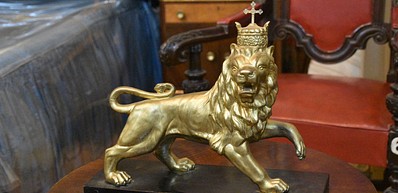
-
![Holy Trinity Cathedral]() Provided by: Sailko/cc by 3.0/Wikimedia Commons
Provided by: Sailko/cc by 3.0/Wikimedia Commons -
![Holy Trinity Cathedral]() Provided by: Kenneth Dedeu/Shutterstock.com
Provided by: Kenneth Dedeu/Shutterstock.com

Our travel guides are free to read and explore online. If you want to get your own copy, the full travel guide for this destination is available to you offline* to bring along anywhere or print for your trip.
*this will be downloaded as a PDF.Price
€4,95
Holy Trinity Cathedral
The guide was updated:The second in importance house of worship in Ethiopia — the Holy Trinity Cathedral — contains the tombs of the Former Emperor Haile Selassie and his wife. Many more prominent figures of the country's history are buried on its compounds. The building itself is a curious mix of international styles.
Useful Information
- Address: Niger Street, Addis Ababa
- More Info: Belongs to the Ethiopian Orthodox Tewahedo Church
- Website: www.htc.org.et
Digital Travel Guide Download
Our travel guides are free to read and explore online. If you want to get your own copy, the full travel guide for this destination is available to you offline* to bring along anywhere or print for your trip.
*this will be downloaded as a PDF.Price
€4,95

The capital's Ethnological Museum is considered to be one of the finest on the continent. Intricately arranged exhibits narrate the story of Ethiopia and its peoples. The museum spans two floors of the former residence of Emperor Haile Selassie, whose rooms are preserved in nearly their original state and open to visitors. Detailed written explanations are provided.
Read more

National Museum of Ethiopia
The National Museum of Ethiopia contains a plethora of cultural artefacts. Its most notable exhibit, however, is the cast of Lucy — a female skeleton of the Australopithecus afarensis species, discovered in Ethiopia in 1974 and dating back as far as 3.2 million years. Art lovers will appreciate the museum's collection of Ethiopian art from the 14th to the 20th centuries.
Read more

Red Terror Martyrs' Memorial Museum
The chilling, heartbreaking exhibits of the Red Terror Martyrs' Memorial Museum are guaranteed to leave no visitor indifferent. Atrocities commuted during Mengistu’s Derg regime are laid bare, to be processed at your own pace or with an English-speaking guide. The museum operates on donations alone; entry is free of charge.
Read more

Entoto Hills
A steep climb (or car ride) up Mount Entoto is worth the time if only for the spectacular views over sprawling Addis Ababa unfolding from the top. On Sunday, the hilltop Maryam Church is open for mass (closed other days of the week), and the Entoto Maryam Museum showcases artefacts and personal belongings of Emperor Menelik, whose humble palace still stands not too far away.
Bookable
Read more

St George Cathedral & Museum
Typically octagonal, the stern-looking, neoclassical St George Cathedral was where Ethiopian rulers were inaugurated ever since its construction by the order of Emperor Menelik II, who dedicated the church to Ethiopia's patron saint, St George. Adjacent to the church is a museum with religious paraphernalia.
Read more

Merkato
It takes heart to venture into the chaotic-looking, sprawling marketplace of Addis Ababa. Despite the first impression, the market is very much organised, subdivided into "quarters" dedicated to a specific kind of wares. Definitely come with a guide to help you navigate. Many vendors keep goods inside their permanent stalls, so what is being sold might not be apparent at first glance. Items worth browsing for are leather goods, silver jewellery, spices, and more.
Bookable
Read more

Holy Trinity Cathedral
The second in importance house of worship in Ethiopia — the Holy Trinity Cathedral — contains the tombs of the Former Emperor Haile Selassie and his wife. Many more prominent figures of the country's history are buried on its compounds. The building itself is a curious mix of international styles.
Read more

Piazza
The capital's atmospheric "old town" is known as the Piazza. The name gestures towards the brief period of the Italian presence in the country. The area still has hints of Italian in its vibe today, and there are a few landmarks remaining from the first half of the 20th century. This is the go-to neighbourhood for good places to eat and budget accommodation.
Read more

Lion of Judah & Churchill Avenue
The Lion of Judah marks the beginning of Churchill Avenue, one of the city's main shopping streets, which runs from the railway stations straight into the popular Piazza neighbourhood. The statue is the symbol of Ethiopian monarchy. Its original, executed in gilded bronze, was relocated back to Ethiopia from Rome in the 60s and now in the collection of the National Museum of Ethiopia.
Read more

Bata Mariam Mausoleum
A hidden door inside leads into the crypt, where several Ethiopian royals are buried, along with Emperor Menelik himself. The marble tombs are a stunning discovery in themselves, but the real kicker is an original painting by Michelangelo also on display here. Come with a guide to get the full experience.
Read more

Menelik Palace & Unity Park
The Menelik Palace is a palatial compound that was the seat of the power of Emperors of Ethiopia. Today, the compound is called Unity Park and contains are several residences, halls, chapels, and working buildings. Visit the Gibr Adarash banquet hall, the Zufan Adarash throne room, the mausoleum that is Emperor Menelik II's last resting place, and the Shengo Hall event hall. The Prime Minister's Office and residence is located here, too, which means that security is pretty strict — bring an ID.
Read more

Zoma Museum
The Zoma Museum is an environmentally conscious artist in residency project. The museum has been influential in the contemporary Ethiopian visual art sector and as a conduit for Ethiopian artists to be featured internationally. Zoma is also a good place to see local plants and explore traditional house making styles made of mud. There's a cafe and a restaurant, too.
Read more



